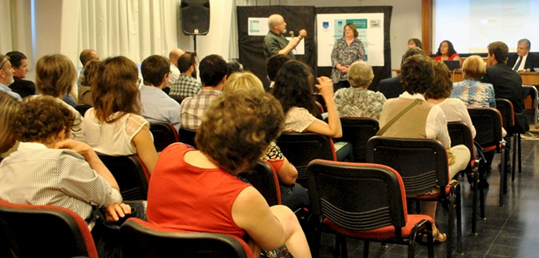On December 4th, the Facultad de Odontología, Universidad de la República del Uruguay achieved a significant and pioneering step for the scientific publications of the country. The journal Odontoestomatología became the first one to be published online and completely in English in SciELO Uruguay.
This breakthrough, which includes Odontoestomatología on the “radar” of scientific publications internationally, was the result of strategic planning and hard work for more than eight years of the Publications Department of the Faculty, led by Prof. Dr. Maria del Carmen López Jordí, and supported by the Dean of the Facultad de Odontología, Prof. Dr. Hugo Calabria.
Considering the importance of the event we interviewed Dr. López Jordí, which is summarized below.
1. Prof. López Jordí, please tell us how was the beginning of the journal Odontoestomatología.
The editorial management of an academic journal is an exciting and difficult task, which involves a huge responsibility, since the editorial board is ultimately responsible and channeling, who seeks to provide the scientific community with the best contributions and the most significant advances in the scientific fields covered by the journal.
When an academic journal fails in its ethical standards and good practices, all aspects of the editorial process will be affected. There is no doubt that the quality of a scientific journal is based on its rigor, prestige and international visibility, which in turn depends on many factors come into play in the daily task of the editorial management.
Odontoestomatología started in 2002, as the result of a fusion of old printed journals, which had been produced by the Faculty, together with Anales and Odontoposgrado. As such they played an important role, resulting in good but sporadic issues. As you know, when there were enough papers and the money needed.
2. How was the journey from the old printed only journal to the online version in English with international reach through SciELO?
From 2006, after the conformation of the Publications Unit (now Department) a process characterized by the professionalization of the editorial process has started. At that time, with Dr. Beatriz Casnati, who besides being a dentist is also an archivist, we began a journey of learning, from humility, a dialogue with experienced players (as good listeners) taking small but sure steps that allowed us to climb positions, achieve goals and take on new challenges. Then, in 2010 we incorporated Mrs. Carina Patrón, a librarian of our Faculty.
At that stage we reached indexing Odontoestomatología in LILACS database from BIREME/PAHO/WHO, in the regional index Latindex, in SciELO Portal at national level and in the VHL Dentistry.
Teamwork was strengthened by interdisciplinary contributions and so from 2013 the journal was accepted and included in Cite Factor Server, Sherpa-Romeo Service and the Web Qualis Capes System (which is important for those undergoing graduate courses in Brazil).
3. What is the current status of Odontoestomatología that gave it the impetus to move to all-English?
Presently, with a trajectory of the Department for eight years based on academic rigor and an editorial policy that was developed and proposed by the Department, but was soon discussed and approved by the Faculty Council, we have been complying strictly with the methodological requirements of such type of journals, allowing Odontoestomatología today to be nationally and regionally recognized. The editorial board of the journal, as well as the team of reviewers, has professionals from five different countries, besides Uruguay.
From 2006 to 2014 were published in Odontoestomatología 98 articles by 214 different authors. Of these, 121 are from Uruguay, 45 from Brazil, 17 from Argentina, 17 from Chile, 5 from Peru, 3 from Colombia, 2 from Dominican Republic, 1 from the United States, 1 from Mexico, 1 from Australia and 1 from Sweden, which is relevant to overcome the undesired effect of journal inbreeding. These figures show that 55% of the authors are Uruguayans, and 45% are foreign, a figure we now expect to improve, since we now fully publish in English.
Then, in a note dated from May 12th, 2014, we sent to the Faculty Council the report that this same Council requested us from an initiative of the Dean Dr. Hugo Calabria, on the possibility of translation into English language the journal Odontoestomatología and the benefits that it would entail. In the note we said:
As background and justification it is important to know, firstly, that the amount of scientific journals in English language is vastly superior to those published in other languages. The international situation certifies that, in general, editing a journal in English facilitates its indexing in international databases (e.g. PubMed), raising the Impact Factor.
Institutional evidence from research work developed at the Publications Department in 20131 clearly shows the familiarity of the authors and readers of Odontoestomatología with the English language since 66% of the citations made by the journal are to publications in English.
A priority line of action of SciELO is internationalization which, among other strategies, includes the progressive adoption of English for communication of research, with the aim of expanding its international visibility. While the decision to publish in English is the journal’s, SciELO points out that more and more journals are adopting English, either as the sole language of communication in multilingual format or together with the Spanish or Portuguese.
In this way of thinking we can conclude that the English version of Odontoestomatología opens up a world of knowledge that is there, within reach. We believe that language differences should not be difficult obstacles to avoid, but steps to advance our growth and evolution as scientists, professionals and individuals in society, worthwhile to use in our benefit and the institution’s.
However, besides the analysis of this topic by the Publications Department, it is included the proposal to the Council that the English version of Odontoestomatología be edited online, thereby relevantly increasing its potential audience.
We consider that maybe it is time to start thinking that reading on paper or on screen does not represent an old technology and its inevitable replacement, but rather that both are useful as different paths to knowledge.
Considering science as a global enterprise, the English and online edition of Odontoestomatología would bring nothing but benefits to the institution, authors and users and both measures will affect the quality and impact. In short, given the benefits considered for both editions, the members of the Publications Department considered urgent to add the English translation and online edition to the printed edition of Odontoestomatología in order to meet international standards of an arbitrated quality open access journal to scientific knowledge that domestic and foreign authors trust to this Institution.
Report approved by the Faculty Council by Resolution 44 on June 28th, 2014 (outlined in the original version).
4. How do you see the future of Odontoestomatología on this new phase?
From there we started this new challenge presented today, we added a lot of homework, administrative steps to select and hire a Certified Translator, which is doing a great job; to achieve the task of having have the same journal format in English and in Spanish, to start in SciELO a new era of publishing journals in English, since Odontoestomatología is the first of all journals that integrate the SciELO portal Uruguay to be available in English language and the first of the three journals of Universidad de la República that are part of this portal.
Today we celebrate this great achievement but be assured that we will continue this path of development in the communication of knowledge, because in the spirit of this team, there will always be ideas becoming reality.
Photos of the event
From left to right:
Facultad de Odontología. Universidad de la República del Uruguay
- Dr. Sylvia Piovesan, Executive Secretary. Publications Department.
- Mrs. Carina Patrón. Librarian. Publications Department.
- Prof. Dr. María del Carmen López Jordi. Director of Publications Department.
- Prof. Dr. Hugo Calabria. Dean. Faculty of Dentistry.
- Prof. Dr. Tabaré Ravecca. Director of Graduated School.
Photo of the presentation session
Note
1 PATRON, C., et al. Análisis bibliométrico de la producción científica de la revista Odontoestomatología. Odontoestomatología [online]. 2014, vol. 16, nº 23, pp. 34-43. [viewed 16 December 2014]. ISSN 1688-9339. Available from: http://www.scielo.edu.uy/scielo.php?script=sci_arttext&pid=S1688-93392014000100005&lng=es&nrm=iso.
External links
VHL – Virtual Health Library in Dentistry – <http://www.bvsodon.org.uy/>
Odontoestomatología in SciELO Uruguay – <http://www.scielo.edu.uy/scielo.php?script=sci_serial&pid=1688-9339&lng=es&nrm=iso>
 About Ernesto Spinak
About Ernesto Spinak
Collaborator on the SciELO program, a Systems Engineer with a Bachelor’s degree in Library Science, and a Diploma of Advanced Studies from the Universitat Oberta de Catalunya (Barcelona, Spain) and a Master’s in “Sociedad de la Información” (Information Society) from the same university. Currently has a consulting company that provides services in information projects to 14 government institutions and universities in Uruguay.
Como citar este post [ISO 690/2010]:




















Recent Comments